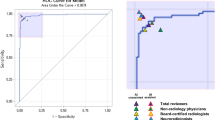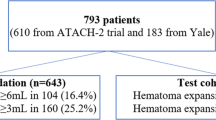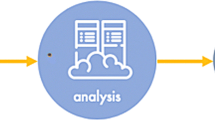Abstract
Hemorrhagic stroke is a serious clinical condition that requires timely diagnosis. An artificial intelligence algorithm system called DeepCT can identify hemorrhagic lesions rapidly from non-contrast head computed tomography (NCCT) images and has received regulatory clearance. A non-controlled retrospective pilot clinical trial was conducted. Patients who received NCCT at the emergency department (ED) of Kaohsiung Veteran General Hospital were collected. From 2020 January-1st to April-30th, the physicians read NCCT images without DeepCT. From 2020May-1st to August-31st, the physicians were assisted by DeepCT. The length of ED stays (LOS) for the patients was collected. 2,999 patients were included (188 and 2811 with and without ICH). For patients with a final diagnosis of ICH, implementing DeepCT significantly shortened their LOS (560.67 ± 604.93 min with DeepCT vs. 780.83 ± 710.27 min without DeepCT; p = 0.0232). For patients with a non-ICH diagnosis, the LOS did not significantly differ (705.90 ± 760.86 min with DeepCT vs. 679.45 ± 681.97 min without DeepCT; p = 0.3362). For patients with ICH, those assisted with DeepCT had a significantly shorter LOS than those without DeepCT. For patients with a non-ICH diagnosis, implementing DeepCT did not affect the LOS, because emergency physicians need same efforts to identify the underlying problem(s) with or without DeepCT. In summary, implementing DeepCT system in the ED will save costs, decrease LOS, and accelerate patient flow; most importantly, it will improve the quality of care and increase the confidence and shorten the response time of the physicians and radiologists.


Similar content being viewed by others
References
Majumdar A, Brattain L, Telfer B, Farris C, Scalera J: Detecting intracranial hemorrhage with deep learning. In: 2018 40th annual international conference of the IEEE engineering in medicine and biology society (EMBC): 2018: IEEE; 2018: 583–587.
Hemphill III JC, Greenberg SM, Anderson CS, Becker K, Bendok BR, Cushman M, Fung GL, Goldstein JN, Macdonald RL, Mitchell PH: Guidelines for the management of spontaneous intracerebral hemorrhage: a guideline for healthcare professionals from the American Heart Association/American Stroke Association. Stroke 2015, 46(7):2032-2060.
Qureshi AI, Mendelow AD, Hanley DF: Intracerebral haemorrhage. The Lancet 2009, 373(9675):1632-1644.
Li L, Wei M, Liu B, Atchaneeyasakul K, Zhou F, Pan Z, Kumar SA, Zhang JY, Pu Y, Liebeskind DS: Deep learning for hemorrhagic lesion detection and segmentation on brain ct images. IEEE Journal of Biomedical and Health Informatics 2020, 25(5):1646-1659.
Rymer MM: Hemorrhagic stroke: intracerebral hemorrhage. Missouri medicine 2011, 108(1):50.
Mensah GA, Norrving B, Feigin VL: The global burden of stroke. Neuroepidemiology 2015, 45(3):143-145.
Carter JA, Curry W: Intracerebral hemorrhage: pathophysiology and management for generalists. Hospital Medicine Clinics 2017, 6(1):95-111.
Ginat DT: Analysis of head CT scans flagged by deep learning software for acute intracranial hemorrhage. Neuroradiology 2020, 62(3):335-340.
Expert Panel on Neurologic I, Salmela MB, Mortazavi S, Jagadeesan BD, Broderick DF, Burns J, Deshmukh TK, Harvey HB, Hoang J, Hunt CH et al: ACR Appropriateness Criteria((R)) Cerebrovascular Disease. J Am Coll Radiol 2017, 14(5S):S34-S61.
McDonald RJ, Schwartz KM, Eckel LJ, Diehn FE, Hunt CH, Bartholmai BJ, Erickson BJ, Kallmes DF: The effects of changes in utilization and technological advancements of cross-sectional imaging on radiologist workload. Academic radiology 2015, 22(9):1191-1198.
Mouridsen K, Thurner P, Zaharchuk G: Artificial intelligence applications in stroke. Stroke 2020, 51(8):2573-2579.
Litjens G, Kooi T, Bejnordi BE, Setio AAA, Ciompi F, Ghafoorian M, Van Der Laak JA, Van Ginneken B, Sánchez CI: A survey on deep learning in medical image analysis. Medical image analysis 2017, 42:60-88.
Islam MM, Yang H-C, Poly TN, Li Y-CJ: Development of an artificial intelligence–based automated recommendation system for clinical laboratory tests: Retrospective analysis of the national health insurance database. JMIR medical informatics 2020, 8(11):e24163.
Xu Y, Holanda G, Fabrício L, de F S, Silva H, Gomes A, Silva I, Ferreira M, Jia C, Han T: Deep learning-enhanced Internet of medical things to analyze brain CT scans of hemorrhagic stroke patients: A new approach. IEEE Sensors Journal 2020.
Hsing AW, Ioannidis JPA: Nationwide Population Science: Lessons From the Taiwan National Health Insurance Research Database. JAMA Internal Medicine 2015, 175(9):1527-1529.
Wang CJ, Ng CY, Brook RH: Response to COVID-19 in Taiwan: Big Data Analytics, New Technology, and Proactive Testing. JAMA 2020, 323(14):1341-1342.
Tsai C-Y, Yang H-C, Islam M, Hsieh W-S, Juan S-H, Chen J-C, Khan HAA, Jian W-S: Psychotropic medications prescribing trends in adolescents: A nationwide population-based study in Taiwan. International Journal for Quality in Health Care 2017, 29(6):861-866.
Wang H-C, Chou J-H, Chiu W-T, Nien H-C, Jr. JL: Validation of a deep learning algorithm to detect acute intracranial hemorrhage on non-contrast brain CT. In: 2nd International Conference of AI in Healthcare (ICAIH). Los Angeles, CA; 2019.
Kuo W, Hӓne C, Mukherjee P, Malik J, Yuh EL: Expert-level detection of acute intracranial hemorrhage on head computed tomography using deep learning. Proceedings of the National Academy of Sciences 2019, 116(45):22737-22745.
Morley C, Unwin M, Peterson GM, Stankovich J, Kinsman L: Emergency department crowding: a systematic review of causes, consequences and solutions. PloS one 2018, 13(8):e0203316.
Schreyer KE, Martin R: The economics of an admissions holding unit. Western Journal of Emergency Medicine 2017, 18(4):553.
Chatterjee A, Somayaji NR, Kabakis IM: Abstract WMP16: Artificial Intelligence Detection of Cerebrovascular Large Vessel Occlusion - Nine Month, 650 Patient Evaluation of the Diagnostic Accuracy and Performance of the Viz.ai LVO Algorithm. Stroke 2019, 50(Suppl_1):AWMP16-AWMP16.
Murray NM, Unberath M, Hager GD, Hui FK: Artificial intelligence to diagnose ischemic stroke and identify large vessel occlusions: a systematic review. Journal of NeuroInterventional Surgery 2020, 12(2):156-164.
FDA approves stroke-detecting AI software. Nature Biotechnology 2018, 36(4):290-290.
Hassan AE, Ringheanu VM, Rabah RR, Preston L, Tekle WG, Qureshi AI: Early experience utilizing artificial intelligence shows significant reduction in transfer times and length of stay in a hub and spoke model. Interventional Neuroradiology 2020, 26(5):615-622.
Davis MA, Rao B, Cedeno P, Saha A, Zohrabian VM: Machine Learning and Improved Quality Metrics in Acute Intracranial Hemorrhage by Non-Contrast Computed Tomography. Current Problems in Diagnostic Radiology 2020.
Author information
Authors and Affiliations
Corresponding author
Ethics declarations
Ethics approval and consent to participate
This study approved by the Joint Institutional Review Board (KSVGH20-CT10-12) of Kaohsiung Veteran General Hospital (KSVGH). All the participants had informed consent. The medical device used for the study had premarket notification by regulatory agencies (US FDA 510(k) No.: K182875 and Taiwan Food and Drug Administration (TFDA) license No.: MOHW-MD-No. 006649).
Conflicts of interest
The authors declare no conflict of interest.
Additional information
Publisher's Note
Springer Nature remains neutral with regard to jurisdictional claims in published maps and institutional affiliations.
This article is part of the Topical Collection on Clinical Systems
Rights and permissions
About this article
Cite this article
Chien, HW.C., Yang, TL., Juang, WC. et al. Pilot Report for Intracranial Hemorrhage Detection with Deep Learning Implanted Head Computed Tomography Images at Emergency Department. J Med Syst 46, 49 (2022). https://doi.org/10.1007/s10916-022-01833-z
Received:
Accepted:
Published:
DOI: https://doi.org/10.1007/s10916-022-01833-z




